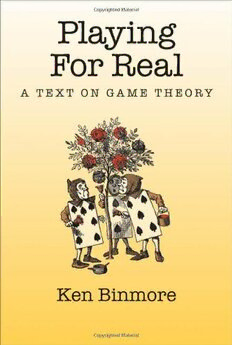Table Of ContentPlaying for Real
This page intentionally left blank
Playing for Real
A Text on Game Theory
Ken Binmore
1
2007
1
OxfordUniversityPress,Inc.,publishesworksthatfurther
OxfordUniversity’sobjectiveofexcellence
inresearch,scholarship,andeducation.
Oxford NewYork
Auckland CapeTown DaresSalaam HongKong Karachi
KualaLumpur Madrid Melbourne MexicoCity Nairobi
NewDelhi Shanghai Taipei Toronto
Withofficesin
Argentina Austria Brazil Chile CzechRepublic France Greece
Guatemala Hungary Italy Japan Poland Portugal Singapore
SouthKorea Switzerland Thailand Turkey Ukraine Vietnam
Copyright#2007byOxfordUniversityPress,Inc.
PublishedbyOxfordUniversityPress,Inc.
198MadisonAvenue,NewYork,NewYork10016
www.oup.com
OxfordisaregisteredtrademarkofOxfordUniversityPress
Allrightsreserved.Nopartofthispublicationmaybereproduced,
storedinaretrievalsystem,ortransmitted,inanyformorbyanymeans,
electronic,mechanical,photocopying,recording,orotherwise,
withoutthepriorpermissionofOxfordUniversityPress.
LibraryofCongressCataloging-in-PublicationData
Binmore,K.G.,1940–
Playingforreal:atextongametheory/KenBinmore.
p.cm.
Includesindex.
ISBN978-0-19-530057-4
1. Gametheory. 1. Title.
QA269.B4752005
519.3—dc22 2005053938
1 3 5 7 9 8 6 4 2
PrintedintheUnitedStatesofAmerica
onacid-freepaper
I dedicate Playing for Real to my wife, Josephine
This page intentionally left blank
Preface
There are at least threequestions agametheorybook might answer:
What is game theory about?
How do I apply game theory?
Why is game theory right?
Playing for Real tries to answer all three questions. I think it is the only book that
makes a serious attempt to do so without getting heavily mathematical. There are
elementary books that offer students the opportunity to admire some game theory
concepts. There are cookbooks that run through lots of applied models. There are
philosophical works that supposedly address the foundational issues, but none of
theseaddressmorethan two of the questions.
However, answering questions is only part of what this book is about. Just as
athletestakepleasureintrainingtheirbodies,sothereisimmensesatisfactiontobe
found in training your mind to think in a way that is simultaneously rational and
creative.Withallofitspuzzlesandparadoxes,gametheoryprovidesamagnificent
mental gymnasium for this purpose. I hope that exercising on the equipment will
bringyouthe samekind ofpleasure ithas broughtme.
Moving on. Playing for Real isn’t my first textbook on game theory. My earlier
book,FunandGames,wasusedquitewidelyforteachingadvancedundergraduate
andbeginninggraduatestudents.Ihadoriginallyplannedamodestlyrevisedsecond
edition, in which the rather severe introduction would be replaced with a new
chapterthatwouldeasestudentsintothesubjectbyrunningthroughalltheangleson
the Prisoners’ Dilemma. The remaining chapters were then simply to be broken
down into more digestible chunks. But the project ran away with me. I made the
improvements Iplannedto make butsomehow ended up with a whole new book.
There are two reasons why. The first is that game theory has moved on since I
wrote Fun and Games. Some of the decisions on what material to include that
viii Preface
seemed a little daring at the time now look totally uncontroversial. So I have tried
myluck at guessingwhich way the subject is going tojump again.
The second reason is that I have moved on as well. In particular, I have done a
greatdealofconsultingwork,applyinggametheorytoreal-worldproblemsinorder
to raise money for my research center. The biggest project was the design of a
telecomauctionthatraised$35billion.Ialwaysknewthatgametheoryworks,but
seeingittriumphonsuchascalewasbeyondallexpectation!Ihavealsowrittena
book applying game theory to philosophical issues, which taught me a great deal
abouthowandwhybeginnersmakemistakeswhenthinkingaboutstrategicissues.
BothkindsofexperiencehavecontributedtomakingPlayingforRealabetterbook
than its predecessor. My flirtation with philosophy even generated a lot of light-
hearted exercises that nevertheless make genuinelyserious points.
Material. As a text on game theory for undergraduates with some mathematical
training, Playing for Real improves on Fun and Games in a number of ways. It
continues to be suitable for courses attended by students from a variety of disci-
plines. (Some of my very best undergraduates at the University of Michigan were
from Classics.) It also continues to provide backup sections on the necessary
mathematics,sothatstudentswhoseskillsarerustycankeepupwithwhat’sgoing
onwithouttoomucheffort.However,thebookasawholecoversfewerbasictopics
in a more relaxed and discursive style, with many more examples and economic
applications.
I hope the opening chapter, which uses the Prisoners’ Dilemma to provide an
undemanding overview of what game theory is all about, will prove to be a par-
ticularly attractive feature. Economists will also be pleased to see a whole chapter
devoted to the theory of imperfect competition, where I believe I may even have
madeBertrand-Edgeworthcompetitionaccessibletoundergraduates.Itisatragedy
thatevolutionarygametheoryhadtogo,butthisimportantsubjecthasgottensobig
thatit deserves awholebook toitself.
Althoughfewertopicsarecovered,sometopicsarecoveredinmuchmoredetail
thaninFunandGames.Theseincludecooperativegametheory,Bayesiandecision
theory, games of incomplete information, mechanism design, and auction theory,
each of which now has its own chapter. However, the theory of bargaining has
grown more than anything else, partly because I hope to discourage various mis-
understandingsofthetheorythathavebecomecommonplaceinappliedwork,and
partlybecauseIwantedtoillustrateitspotentialuseinethicsandmoralphilosophy.
Teaching. There is enough material in this book for at least two courses in game
phil theory,evenleavingasidethereviewandothersectionsthatareintendedforprivate
reading. Ihave tried tomakethings easyfor teacherswho want todesignacourse
basedonaselectionoftopics fromthe wholebookbyincludingmarginal notesto
facilitate skipping. For example, the Mad Hatter, who has appeared in the margin,
suggests skipping on to the first chapter, on the grounds that there is too much
! 1.1
philosophyin thispreface.
The exercises are similarly labeled with warnings about their content. Nobody
will want to attempt all of the enormous number of exercises, but when I teach, I
insist on students trying asmallnumber ofcarefullychosenexercises every week.
Preface ix
Once they get into the habit, students are often surprised tofind thatsolvingprob-
lems can be a lotof fun.
By the time the book is published, Jernej Copic will have finished getting his
solutions onto a website. Oxford University Press will provide access details to
recognized teachers.
Thanks. Somanypeoplehavehelpedme,withbothFunandGamesandPlayingfor
Real,thatIhavelosttrackofthemall.Ishallthereforementiononlytheveryspecial
debt of gratitude I owe to my long-time coauthor, Larry Samuelson, for both his
patience and his encouragement. I also want to thank the California Institute of
Technology for giving me the leisure to complete this book as a Gordon Moore
Scholar. I should also acknowledge the Victorian artist John Tenniel, whose mag-
nificentillustrationsfromLewisCarroll’sAlicebooksIhaveshamelesslystolenand
messed around with.
Apologies. Let me aopolgize in advance for the errors that have doubtless found
theirwayintoPlayingforReal.Ifyoufindanerror,pleasejointhemanyotherswho
have helped me by letting me know about it at k.binmore@ucl.ac.uk. I will be
genuinely grateful.
Finally,Ineedtoapologizenotonlyformymistakesbutalsoformyattemptsat
humor. Oscar Wilde reported that a piano in a Western saloon carried a notice
saying,‘‘Pleasedon’tshootthepianist.He’sdoinghisbest.’’Thesamegoesforme,
too. It isn’t easy to write in a light-hearted style when presenting mathematical
material, butIdid mybest. Ken Binmore

